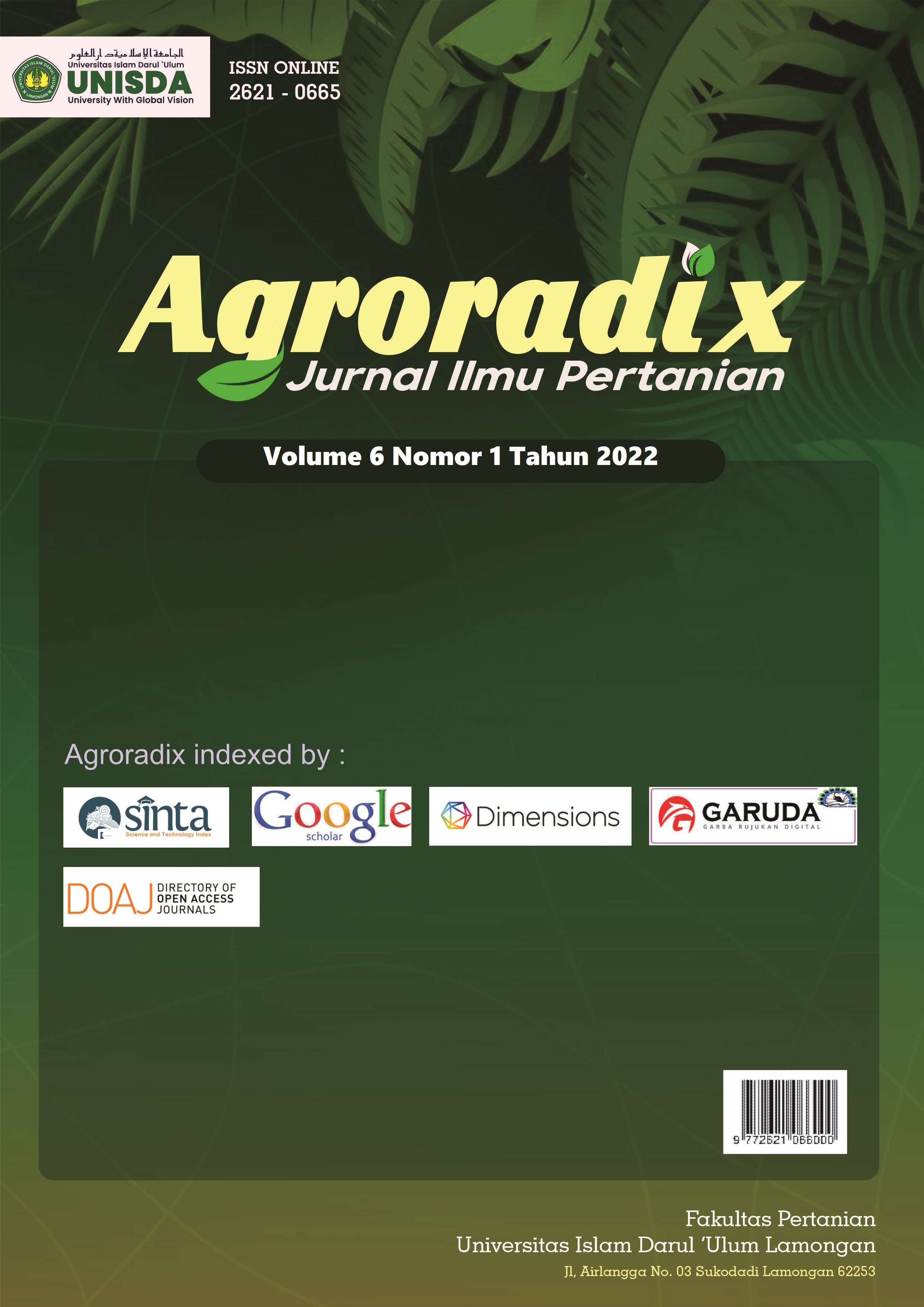Pengaruh Biochar Sekam dan biourine Terhadap Pertumbuhan dan Produksi Tanaman Padi (Oryza sativa L.)
Abstract
This research activity aims to determine the different doses of husk biochar and biourine on the growth and production of rice plants. The activity was carried out in Bulubrangsi Village, Laren, Lamongan, from February to May 2022. The design is Factorial RAK. The first factor was the different doses of biochar husk consisting of control or without biochar, 5 t/ha, 10 t/ha. The second factor was the type of biourine which consisted of no biourine, cow biourine, goat biourine. There were 9 treatment combinations with 3 repetitions. In the vegetative phase observed plant height and number of leaves while the generative phase was plant wet weight, panicle length, dry seed weight, dry seed weight per plot, 1000 seed weight. Data processing was analyzed using ANOVA, if there is a significant difference then proceed with the BNT test. The conclusion showed that there was an interaction between the various doses of biochar and biourine treatments on plant height aged 14 and 28 days after planting, number of tillers aged 14 and 42 days after planting. panicle length ages 63, 70, 77, and 84 dap, as well as grain weight per 1000 seeds, fresh weight per plot, and fresh weight per hectare. The best treatment combination was rice husk biochar 10 t/ha and goat biourine.
Downloads
References
Brewer, C. E., Schmidt-Rohr, K., Satrio, J. A., & Brown, R. C. (2009). Characterization of biochar from fast pyrolysis and gasification systems. Environmental Progress \& Sustainable Energy: An Official Publication of the American Institute of Chemical Engineers, 28(3), 386–396.
Chan, K. Y., Van Zwieten, L., Meszaros, I., Downie, A., & Joseph, S. (2007). Agronomic values of greenwaste biochar as a soil amendment. Soil Research, 45(8), 629–634.
Dharmayanti, N. K. S., Supadma, A. A. N., & Arthagama, I. D. M. (2013). Pengaruh pemberian biourine dan dosis pupuk anorganik (N, P, K) terhadap beberapa sifat kimia tanah Pegok dan hasil tanaman bayam (Amaranthus sp.). E-Jurnal Agroekoteknologi Tropika, 2(3), 165–174.
Istiqomah, I., Kusumawatii, D. E., Serdani, A. D., & Choliq, F. A. (2022). Pemanfaatan Limbah Jerami, Sekam, Dan Urine Sapi Sebagai Pupuk Organik Untuk Meningkatkan Pertumbuhan Dan Produksi Padi. Jurnal Viabel Pertanian, 16(2), 101–113.
Kalina, M., Sovova, S., Hajzler, J., Kubikova, L., Trudicova, M., Smilek, J., & Enev, V. (2022). Biochar Texture—A Parameter Influencing Physicochemical Properties, Morphology, and Agronomical Potential. Agronomy, 12(8). https://doi.org/10.3390/agronomy12081768
Lashari, M. S., Liu, Y., Li, L., Pan, W., Fu, J., Pan, G., Zheng, J., Zheng, J., Zhang, X., & Yu, X. (2013). Effects of amendment of biochar-manure compost in conjunction with pyroligneous solution on soil quality and wheat yield of a salt-stressed cropland from Central China Great Plain. Field Crops Research, 144, 113–118.
Major, J., Steiner, C., Downie, A., Lehmann, J., & Joseph, S. (2009). Biochar effects on nutrient leaching. Biochar for Environmental Management: Science and Technology, 271.
Masulili, A., Utomo, W. H., & Syechfani, M. S. (2010). Rice husk biochar for rice based cropping system in acid soil 1. The characteristics of rice husk biochar and its influence on the properties of acid sulfate soils and rice growth in West Kalimantan, Indonesia. Journal of Agricultural Science, 2(1), 39.
Mawardiana, M., Sufardi, S., & Husen, E. (2013). Pengaruh residu biochar dan pemupukan NPK terhadap dinamika nitrogen, sifat kimia tanah dan hasil tanaman padi (Oryza sativa L.) musim tanam ketiga. Jurnal Manajemen Sumberdaya Lahan, 2(3), 255–260.
Nurida, N. L., & others. (2014). Potensi pemanfaatan biochar untuk rehabilitasi lahan kering di Indonesia.
Qibtiyah, M., & Pudyartono. (2017). Study kind of biochar and biourine concentrations on growth and production of rice plants (Oryza sativa L.). Agritop, 15(1), 1–8. http://jurnal.unmuhjember.ac.id/
Saragih, J. P. (2017). Tantangan kebijakan pengembangan sektor pertanian di masa datang. Kajian, 21(2), 105–123.
Schmidt, H. P., Kammann, C., Hagemann, N., Leifeld, J., Bucheli, T. D., Sánchez Monedero, M. A., & Cayuela, M. L. (2021). Biochar in agriculture – A systematic review of 26 global meta-analyses. GCB Bioenergy, 13(11), 1708–1730. https://doi.org/10.1111/gcbb.12889
Suciaty, T., Dudung, D., & Eryanto, D. (2015). Pengaruh dosis pupuk kandang sapi dan bobot bibit terhadap pertumbuhan dan hasil tanaman bawang merah (Allium ascalonicum L) kultivar Bima Brebes. Agroswagati Jurnal Agronomi, 3(1).
Sundari, E., Sari, E., & Rinaldo, R. (2012). Pembuatan pupuk organik cair menggunakan bioaktivator biosca dan EM4. Kalium, 2, 0–2.
Zhao, J., Ren, T., Zhang, Q., Du, Z., & Wang, Y. (2016). Effects of biochar amendment on soil thermal properties in the North China Plain. Soil Science Society of America Journal, 80(5), 1157–1166.

This work is licensed under a Creative Commons Attribution-ShareAlike 4.0 International License.







